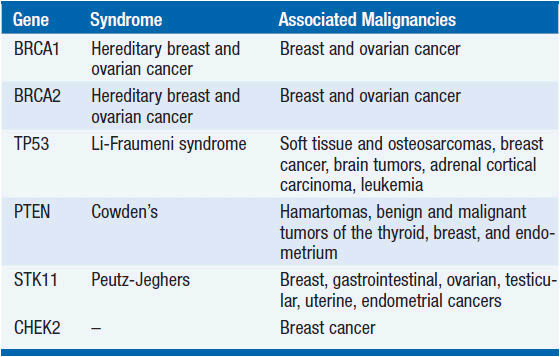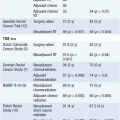Breast Oncology: Clinical Presentation and Genetics
EPIDEMIOLOGY
In the United States, breast cancer is the most commonly diagnosed cancer among women and is second only to lung cancer as the leading cause of cancer-related deaths in women (1). In 2013, approximately 234,000 women will be diagnosed with breast cancer in the United States and 40,000 women will die of the disease. An estimated 2200 men will be diagnosed with breast cancer this year. In the United States, the lifetime probability of developing breast cancer is one in eight (2). Since 1975, breast cancer mortality rates have declined. This decline in mortality is largely attributable to increased use of screening mammography, as well as advances in adjuvant therapy.
RISK FACTORS
Approximately half of women diagnosed with breast cancer have identifiable risk factors besides age and gender. There are specific hormonal and reproductive factors that may increase risk for breast cancer. In addition, a number of lifestyle, diet, and environmental factors confer an increased risk of breast cancer. A personal or family history of breast cancer, as well as a history of benign breast disease, also increases a woman’s risk of developing breast cancer.
 ENDOGENOUS ESTROGEN EXPOSURE/REPRODUCTIVE FACTORS
ENDOGENOUS ESTROGEN EXPOSURE/REPRODUCTIVE FACTORS
It is known that hormonal and reproductive factors influence breast cancer risk. Prolonged exposure to estrogen is associated with an increased risk of breast cancer (3). Estrogen exposure is increased by early menarche, late menopause, and nulliparity, or greater than 30 years of age at birth of the first child. Breastfeeding confers a protective effect on breast cancer risk.
In postmenopausal women, the main source of estrogen is dehydroepiandrosterone (DHEA), which is produced in the adrenal gland and subsequently metabolized to estradiol and estrone. In postmenopausal women, higher serum levels of estrogen correlate with increased breast cancer risk. Higher bone mineral density and increased mammographic breast density, perhaps surrogates for increased long-term exposure to endogenous estrogen, have also been associated with increased breast cancer risk.
 EXOGENOUS ESTROGEN EXPOSURE
EXOGENOUS ESTROGEN EXPOSURE
The role of exogenous estrogen on breast cancer risk is complicated and has been extensively studied. It is generally accepted that past oral contraceptive (OC) use does not result in any significant increase in breast cancer risk in women over 40 years of age. The data on OC use in women with a family history of breast cancer are conflicting. One study suggested that there was an increased risk of breast cancer among women who took OC prior to 1975 (higher dose formulations) and who also had a first degree relative with breast cancer.
Another study, the Women’s Health Initiative (WHI) evaluation of estrogen replacement therapy (ERT) in postmenopausal women, supports a modestly increased associated risk of breast cancer in women taking combined estrogen and progestin therapy (4). Risk appears to rise with increasing duration of use. Short-term use of ERT (less than 4–5 years), however, has not been definitively associated with increased breast cancer risk. In contrast, recent data from the WHI study has shown that use of estrogen alone by postmenopausal women with prior hysterectomy actually decreased the risk of breast cancer (5). At present, the different effects of estrogen plus progestin versus estrogen alone on breast cancer risk are not completely understood.
 LIFESTYLE
LIFESTYLE
Weight and body mass index (BMI) are considered risk factors for breast cancer, although they have opposite influences on pre- and postmenopausal breast cancer. In postmenopausal women, in whom the primary source of estrogen is metabolism of adrenal androgens to estrogens in fatty tissues, obesity is associated with higher serum concentrations of bioavailable estrogen and an increased risk of breast cancer.
In premenopausal women, studies suggest an inverse association between obesity and breast cancer. Obesity is often associated with longer menstrual cycles and increased anovulatory cycles, resulting in less total estrogen exposure and a lower risk of breast cancer.
The relationship between exercise and breast cancer risk remains unsettled. Some data suggest that increased activity levels among postmenopausal women confer a reduced risk of breast cancer. This may be due to the reduction in BMI or the reduced serum estrogen levels associated with exercise.
 DIET
DIET
There is strong epidemiological evidence that breast cancer risk is higher among women who consume moderate to high levels of alcohol (>=3 drinks/day), compared to women who abstain. In the large prospective Nurse’s Health Study, even a low level of alcohol consumption (equivalent to 3–6 glasses of wine per week) was modestly but significantly associated with an increased risk of breast cancer, with a relative risk of 1.15 (95% CI, 1.06–1.24; 333 cases/100,000 person-years) (6). Data also suggest that risk of breast cancer increases linearly with cumulative lifetime alcohol intake, which, in turn, is associated with increased endogenous estrogen levels.
Studies examining fat consumption and breast cancer risk have yielded mixed results, with several case control and cohort studies suggesting at most a modest increase in risk with increased dietary fat consumption.
 ENVIRONMENTAL
ENVIRONMENTAL
The strongest known environmental risk factor for breast cancer is ionizing radiation. Moderate to high doses of ionizing radiation to the chest at a young age such as that given for treatment of Hodgkin’s disease pose a significant risk for the development of breast cancer later in life. The highest risk of breast cancer appears in individuals exposed during prepubertal and pubertal years.
 BENIGN BREAST DISEASE
BENIGN BREAST DISEASE
Benign breast diseases are classified as proliferative or nonproliferative lesions. Non-proliferative lesions are not associated with increased breast cancer risk. Proliferative lesions without atypia such as hyperplasia, sclerosing adenosis, diffuse papillomatosis, radial scar, and complex fibroadenomas result in a small increase in relative risk estimated between 1.5 and 2.0. Proliferative lesions with atypia (atypical ductal hyperplasia, atypical lobular hyperplasia, flat epithelial atypia, and lobular carcinoma in situ) confer an increased risk of invasive breast cancer.
 RISK FACTORS FOR MALE BREAST CANCER
RISK FACTORS FOR MALE BREAST CANCER
Male breast cancer risk factors include a family history of breast cancer, BRCA2 mutations, Klinefelter’s syndrome, chronic liver disease, and testicular conditions such as orchitis, cryptorchidism, and testicular injury. Increased risk of male breast cancer is felt to be due to an imbalance between estrogenic and androgenic influences.
RISK ASSESSMENT
Two useful models to assess breast cancer risk in women not suspected of having a hereditary predisposition to breast cancer (see Breast Cancer Genetics) are the Gail model and the Claus model (7). The Gail model derives age-specific breast cancer risk estimates for women based on their age at menarche, age at first live birth, number of previous breast biopsies, presence of atypical hyperplasia in prior breast biopsy, and number of firstdegree relatives with breast cancer. By including only first-degree relatives, the Gail model tends to underestimate risk in women with strong family histories of breast cancer. A breast cancer risk assessment tool based on the Gail model can be accessed at http://www.cancer.gov/bcrisktool. The Claus model derives age-specific breast cancer risk estimates for women with at least one relative with breast cancer.
BREAST CANCER GENETICS
While 20%–30% of women with breast cancer have at least one relative with a history of breast cancer, only 5%–10% of women with breast cancer have an identifiable hereditary predisposition. Most of the known hereditary breast cancers are due to mutations in the BRCA1 or BRCA2 genes, which also predispose to ovarian cancer. Rare mutations in other genes including PTEN, p53, CDH1, and STK 11 are also associated with increased breast cancer risk (Table 57–1).
Stay updated, free articles. Join our Telegram channel

Full access? Get Clinical Tree






